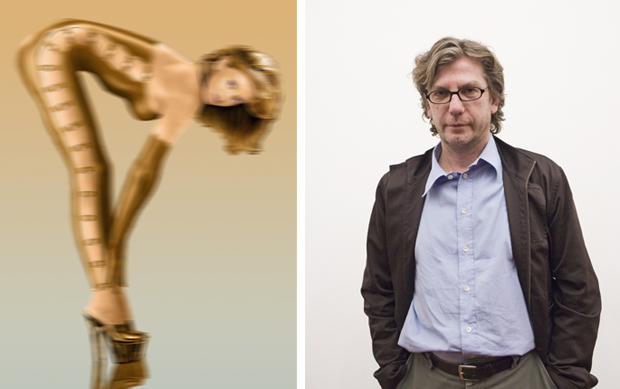
Thomas Ruff’s Heavenly Bodies
"Helmut Newton's view on female bodies is so 19th century" photographer tells Phaidon at Gagosian opening
The German artist Thomas Ruff has fundamentally changed our relationship to the photographic image, moving it beyond reactionary ideas of documentation and supposed “truth” towards a more conceptual, fluid interplay in which the nature of what is perceived as a mere construction of reality is brought into painterly focus. Nothing has provided more fascination for him than the computerized consistency of the ubiquitous digital image. In celebrated series of works spanning thirty years, the artist has forged a career blowing up passport-style pictures, glitch-heavy JPEGS and the minutiae of various appropriated images to gargantuan size, challenging perspective, authorship and the tools of perception.
“I think the desire to change the size of the images has something to do with my generation of photographers,” he tells Phaidon at the opening of his double exhibition at The Gagosian, London, where he is chiefly exhibiting his celebrated internet porn-based series Nudes in conjunction with ma.r.s. – his huge colour-saturated appropriations of NASA images of the red planet. “I think I can quote my colleagues when I say that when we were starting out with photographs we were happy with the images but not happy with the size, because you had paintings three times as large. The physical presence of the photograph was not enough.”

Thomas Ruff, nudes dr02 (2011), unique C-Print, 104, 3/4 x 73 1/4 inches, 266 x 186 cm, © 2012 Thomas Ruff, courtesy Gagosian Gallery
This enlargement process is key to the transformation of what is considered to be a “real” photographic image into a form of imposing physical presence that reveals the original as a fantasy or fiction of sorts – a daydream painted in the mind the via the unquantifiable and unique sociological associations made by the viewer. This is particularly true in the series Nudes, which elevates the mundane pornographic image to the level of high-art, while calling into sharp relief the question of authorship.
“When I researched nudes I felt that Helmut Newton – with his heterosexual male view on female bodies – was so completely 19th century,” says Ruff. “I wanted to bring it to a contemporary state. I thought my nude photographs could be harder and more democratic, and that they should or could show all kinds of sexual action, so I found the images I wanted to use on the porn pages. Most of the images were too small but I found that if I shifted the picture slightly and increased the digital pixilation I would get a more beautiful structure. I had my first nude.”
Thus images that would otherwise be so far outside of the bourgeois sphere that they would be considered crass or shocking become attractive Gerhard Richter-esque ruminations on beauty and the contemporary voyeuristic bastardisation of procreation.

Thomas Ruff, ma.r.s. 03_II, 2011, C-Print, 100, 3/8 x 72 7/8 inches, 255 x 185 cm, © 2012 Thomas Ruff/NASA/JPL/University of Arizona, courtesy Gagosian Gallery
“I think we live in a totally pornographic society, but because these images are all blurred they become less concrete than porn,” says Ruff. “You need a fantasy to look at these images. I admit I did pick images with a certain pictorial quality, so that the image itself is quite attractive, even when it is, let's say, a hardcore gay sex image. But really they are all mirrors, so if you look at these, you look at yourself – if you have a dirty fantasy you see a lot, if you have a nice fantasy, I don’t know what you see…”
And this is the crux of Ruff’s artistic concern – an unflinching investigation into the individual existential viewpoint and our relationship to an environment in which images are more prevalent, more constructed and more manipulated than ever before.
“It’s all about our experience and how we look at the image; the depth,” he says as we stand in front of one of his substrata series of images, which complement the two main strains of the exhibition and explode the garish colours of Manga cartoons into large, hazy psychedelic abstractions, while – perhaps more than any other element – spelling out his confrontational relationship with his own medium.

Thomas Ruff, nudes, sd17, 2011, unique C-Print, 104, 3/4 x 73 1/4 inches, 266 x 186 cm, © 2012 Thomas Ruff, courtesy Gagosian Gallery
“Maybe one of the reasons I did these is because I was just fed up with photography and I wanted to do something completely different – even the sources here are non-photographic,” he says as we stare into the candy-coloured cosmos he has created. “It’s completely created in Photoshop and the only thing that comes from the photographic world is the original print. The rest is completely digitalized – it has nothing to do with photography.”
Ruff studied photography from 1977 to 1985 with Bernd and Hilla Becher at the Kunstakademie Düsseldorf (Düsseldorf Art Academy), where fellow students included the photographers Andreas Gursky, Candida Höfer and Thomas Struth. Commenting on his influences, Ruff said, "My teacher Bernd Becher, showed us photographs by Stephen Shore, Joel Meyerowitz and the new American colour photographers."
Photography, certainly in the traditional sense, is not what is important to Thomas Ruff, what’s important to him is firing the rich and lonely imaginations of his audience - this exhibition does that in spades. Thomas Ruff: ma.r.s runs until April 14, 2012 at Gagosian Gallery, 6-24 Britannia Street, WC1X 9JD. Thomas Ruff nudes runs until April 14, 2012 at Gagosian Gallery 17-19 Davies Street, W1K 3DE.